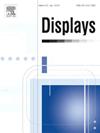ColorBoost-LLIE: A multi-loss guided low-light image enhancement algorithm with decoupled color and luminance restoration
IF 3.7
2区 工程技术
Q1 COMPUTER SCIENCE, HARDWARE & ARCHITECTURE
引用次数: 0
Abstract
Low-light image enhancement (LLIE) aims to improve image brightness and achieve natural-looking images under normal lighting conditions. Existing low-light image enhancement algorithms primarily focus on increasing image brightness, significantly improving the quality of enhanced low-light images. However, these images often suffer from varying degrees of color distortion. To address this issue, we have designed a neural network that separately processes image brightness and color information through distinct sub-networks. Specifically, the input low-light image is converted from the RGB color space to the HSV and Lab color spaces. We then extract features from the brightness and color channels both globally and locally. Finally, the extracted features are fused and decoded to produce the enhanced image. Additionally, we introduce edge loss and color loss functions combined with histogram matching loss and perceptual loss to optimize the training process of the model. By enhancing the restoration of edge and color information, the resulting enhanced images exhibit natural colors with clear details and textures. Extensive experiments demonstrate the effectiveness of our proposed algorithm, particularly in color recovery during low-light image enhancement. It achieves a PSNR of 38.40 and an LPIPS of 0.16 on the LSRW-Huawei dataset and a PSNR, SSIM, and LPIPS of 37.85, 0.85, and 0.14 respectively on the LOL-v2 dataset, Additionally, the algorithm demonstrates impressive enhancement performance on the RichIQA metric (Exploring Rich Subjective Quality Information for Image Quality Assessment in the Wild) and the NLIEE metric (A No-Reference Evaluation Metric for Low-Light Image Enhancement).
求助全文
约1分钟内获得全文
求助全文
来源期刊

Displays
工程技术-工程:电子与电气
CiteScore
4.60
自引率
25.60%
发文量
138
审稿时长
92 days
期刊介绍:
Displays is the international journal covering the research and development of display technology, its effective presentation and perception of information, and applications and systems including display-human interface.
Technical papers on practical developments in Displays technology provide an effective channel to promote greater understanding and cross-fertilization across the diverse disciplines of the Displays community. Original research papers solving ergonomics issues at the display-human interface advance effective presentation of information. Tutorial papers covering fundamentals intended for display technologies and human factor engineers new to the field will also occasionally featured.
 求助内容:
求助内容: 应助结果提醒方式:
应助结果提醒方式:


